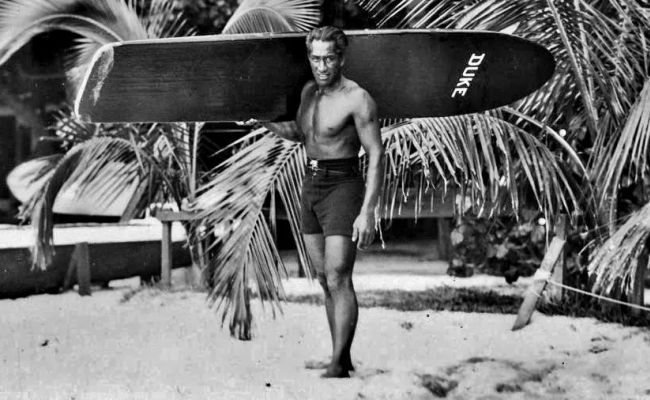Duke Kahanamoku is a swimmer, surfer, water poloist, and actor. Duke Kahanamoku was most popular in the 1800s and early 1900s. Olympic medalist swimmer Duke is known as “The Duke” and “The Big Kahuna.”
Duke was also a member of the Scottish Rite, a Shriner, a police officer, and a beach volleyball player.
He was also the creator of the flutter kick exercise, which is now considered one of the most important workouts.
Table of Contents
Childhood & Family
Duke Kahanamoku was born on August 24, 1890, in Haleakala in Honolulu, Hawaii.
Duke Halapu Kahanamoku (father) and Julia Paakonia (mother) gave birth to him.
Similarly, his father used to work as a cop.
Bernice Pauahi Bishop lived on Haleakala, which was later converted into the Arlington Hotel.
Similarly, Kahanamoku had five brothers and sisters, including Samuel and Sargent.
Duke graduated from Waikiki Grammar School, Kaahumanu School, and he was a strong student, but he was unable to complete his education due to his family’s low socioeconomic status.
Growing up on the outskirts of Waikiki, Kahanamoku spent a lot of time at the beach, honing his surfing and swimming skills.
Kahanamoku loved a traditional surfboard as a child, which he named “Papa Nui” and designed after seeing old Hawaiian surfboards.
Net Worth
Duke Kahanamoku’s net worth is estimated to be $1.9 million.
Facts of Duke Kahanamoku
| Full Name | Duke Paoa Kahinu Mokoe Hulikohola Kahanamoku |
| Date of Birth | August 24, 1890 |
| Birth Place | Haleakala, Honolulu, Kingdom of Hawaii |
| Nick Name | “The Big Kahuna” |
| Religion | Christian |
| Nationality | Hawaiian |
| Ethnicity | Unknown |
| Zodiac Sign | Virgo |
| Death Date | January 22, 1968 |
| Death Place | Honolulu, Hawaii |
| Height | 6’1″ (1.85 meters) |
| Weight | 190 lb (86 kg) |
| Eye Color | Dark Brown |
| Hair Color | Black |
| Father’s Name | Duke Halapu Kahanamoku |
| Mother’s Name | Julia Paakonia Lonokahikini Paoa |
| Siblings | Samuel, David, Louis, Sargent, Bernice, Maria, Bill, and Kapiolani Kahanamoku |
| Education | Kamehameha Schools – Kapālama Campus, President William McKinley High School, Queen Kaʻahumanu Elementary School |
| Marital Status | Married |
| Wife | Nadine Alexander (m. 1940-1968) |
| Kids | None |
| Profession | Swimmer, Surfer, Water poloist, Actor |
| Club | Waikiki Beach Boys |
| Strokes | Freestyle |
| Net Worth | $1.9 million |
| Social Media | None |
| Merch | Book: Waterman: The Life and Times of Duke Kahanamoku Surfer of the Century: The Life of Duke Kahanamoku |
| Hobbies | Surfing |
| Last Update | June 2022 |
Surfing
Duke’s surfboard was constructed by Duke himself from Koa trees, and it was 16 feet long and weighed 114 pounds.
In the seawater of Honolulu Harbor on August 11, 1911, Kahanamoku broke the current world record in the 100-yard freestyle by 4.6 seconds.
Duke was also a superb ukulele player, and when he broke the world record in Honolulu, he became a worldwide phenomenon.
The Hawaiian native began going throughout the world to demonstrate his famous “Kahanamoku Kick” swimming technique.
On December 23, 1914, Duke was the star of the world’s first surfing show, which took place on Freshwater Beach in Sydney, Australia.

Kahanamoku married Nadine Alexander, a dance instructor at the Royal Hawaiian Hotel, in 1940. Surprisingly, the couple had no children.
While Prince visited Hawaii as a fantastic reality, Duke was named after Prince Alfred, Duke of Edinburgh.
Professional Career
In the midst of Olympic rivalries and after withdrawing from the Olympics, Kahanamoku traveled the world to give swimming seminars.
A Hawaiian was the one who promoted surfing all over the world. He demonstrated surfing throughout his voyaging exhibitions.
Prior to Duke’s promotion of the surfing game, only Hawaiians were aware of it.
While living in Southern California in 1912, Duke was the first professional to promote surfing in the United States’ central region.
The surfer was the first individual inducted into the US Olympic Hall of Fame as well as the Swimming and Surfing Halls of Fame.
Kahanamoku also worked as a foundation actor in Hollywood. Following that, he appeared in other films in Southern California as personal entertainment.
In this way, Duke made contacts with people who may help him spread the word about surfing around the world.
Kahanamoku was a member of the Los Angeles Athletic Club, where he worked as a lifeguard and competed in water polo and swimming.
He was the first person to be inducted into both the Swimming and Surfing Halls of Fame.
For the first time, the Kahanamoku Invitational Surfing Championships were held in Hawaii, and the venue was altered.
In the huge surf on Oahu’s North Shore, the most important expert surfing challenge event takes place at any given time.
He is a member of the United States Olympic Hall of Fame. Later, from 1932 to 1961, Kahanamoku was appointed as the Sheriff of Honolulu, Hawaii.
Similarly, he also served as a tactical cop for the United States during World War II.
Olympic Career
In 1912, the great swimmer Kahanamoku qualified for the United States Olympic swimming team, and he also won gold and silver medals for the United States team.
In the 1920 Antwerp Olympics, the local Hawaiian Duke won gold in two 100-meter dashes and the relay.
Duke earned a silver medal in the 100 meters at the 1924 Olympics in Paris. Regardless, his sibling Samuel received the bronze decoration.
Despite this, Duke received no accolades after the age of 34. Duke, on the other hand, competed in the 1932 Summer Olympics as a replacement for the United States in water polo.
The late three-time Olympic gold medalist would be ecstatic that the sport he pioneered is now required for the Tokyo 2020 Olympics.
Surfing was viewed as an Olympic sport when the IOC supported its consideration petition in 2016.
Duke was a central Hawaiian participant at The Outrigger Canoe Club when he was younger.
Duke started the Outrigger Duke Foundation by counting thirds of a comparable Outrigger Canoe Club.
They also had a net worth of $1,239,507 dollars. Indeed, they made money from investments, brand name pay, fundraising, and donations.
They consistently award $76,547 in scholarships and pay $22,698 on brand name-related legal expenditures. They also function as a philanthropic organization to assist an individual financially.
They also host the Dukes Ocean Fest, which is held in August to commemorate Duke’s birthday.
Brand Endorsement
Duke didn’t have a lot of money in his early days. In any event, his distinction later led to a number of intriguing brand underwriting opportunities.
At initially, he had a five-year contract with Branfleet, a clothing company. They jumped on the “Aloha Shirts” trend as a group. As an endorser, Duke added their apparel to the mix.
Similarly, Duke was the first to wear outdoor clothing items in the water, which happened in 1932.
Owen Churchill assisted him with the swimming gear and clothing. Duke remains the awe-inspiring model for “Aloha” brands, and is sometimes referred to as the “Father of Surfing.”
Indeed, they speak to the Duke brand, which represents Hawaii’s culture and way of life.
Duke aided in the construction of a dance club named after him in Waikiki in the 1960s.
Duke operated a Union Oil service station at the intersection of Nuuanu and Pauoa streets in the 1930s.
Duke also ran two distinct petrol stations in Waikiki near Kalakaua and Seaside roads at the same time.
Journey in Acting
Aside from swimming and surfing, Duke had a successful acting career.
Kahanamoku began acting in the 1920s, with a role in the 1925 film “Adventure.” Similarly, he used to play Noah Noa, a character on the show.
In addition, the Hawaiin has been featured in a few films. In the film “The Pony Express,” for example, he played an Indian boss.
Duke also appeared in the film “No Father To Guide Him.” In the film “Lord Jim,” he also played a lifeguard and Tamb Itam.
Duke appeared as a private skipper in the film “Old Ironsides” the next year, in 1926. He also appeared in the 1927 film “Hula” as a Hawaiian adolescent and in the film “Isle of Sunken Gold” as Lono.
Physical Appearance
Duke Kahanamoku was a well-known surfer and swimmer with a dark skin tone due to his ethnic origin. The surfer stood 1.85 meters tall and weighed 190 pounds, which complemented his features.
Similarly, when Duke devised the exercise flutter kick, he had a powerful body and a ripped six-pack.
The Olympic gold champion had black hair and a dark-brown eye to go along with it.
Also read: Kyoko Kimura Cristina Servin David Goggins
Death and the Afterlife
Duke died on January 22, 1968, at the age of 77, from respiratory failure.
First and foremost, a large procession of mourners led by a 30-man police escort.
They continued to transport Duke across town to Waikiki Beach for his ocean burial at that time.
Furthermore, Reverend Abraham Akaka was in charge of the event. He was a Kawaiahao Church minister.
The Duke’s cinders (ashes) were also scattered into the sea by Kahanamoku’s family. Kahanamoku, as previously stated, is the only person inducted into both the Surfing and Swimming Halls of Fames.
In Freshwater Beach, Australia, on the northern tip of South Wales, where he held his swimming displays, he has a sculpture.
There are also additional sculptures dedicated to Duke in various locations.
His Waikiki interment location has one of the statues.
Furthermore, the City of Honolulu revealed it in 1990. Duke’s bronze sculpture was created by Jan Gordon Fisher and stands 9 feet tall.
On February 28, 2015, New Zealand unearthed a replica of Kahanamoku’s surfboard to commemorate Duke’s 100th visit to New Brighton.




